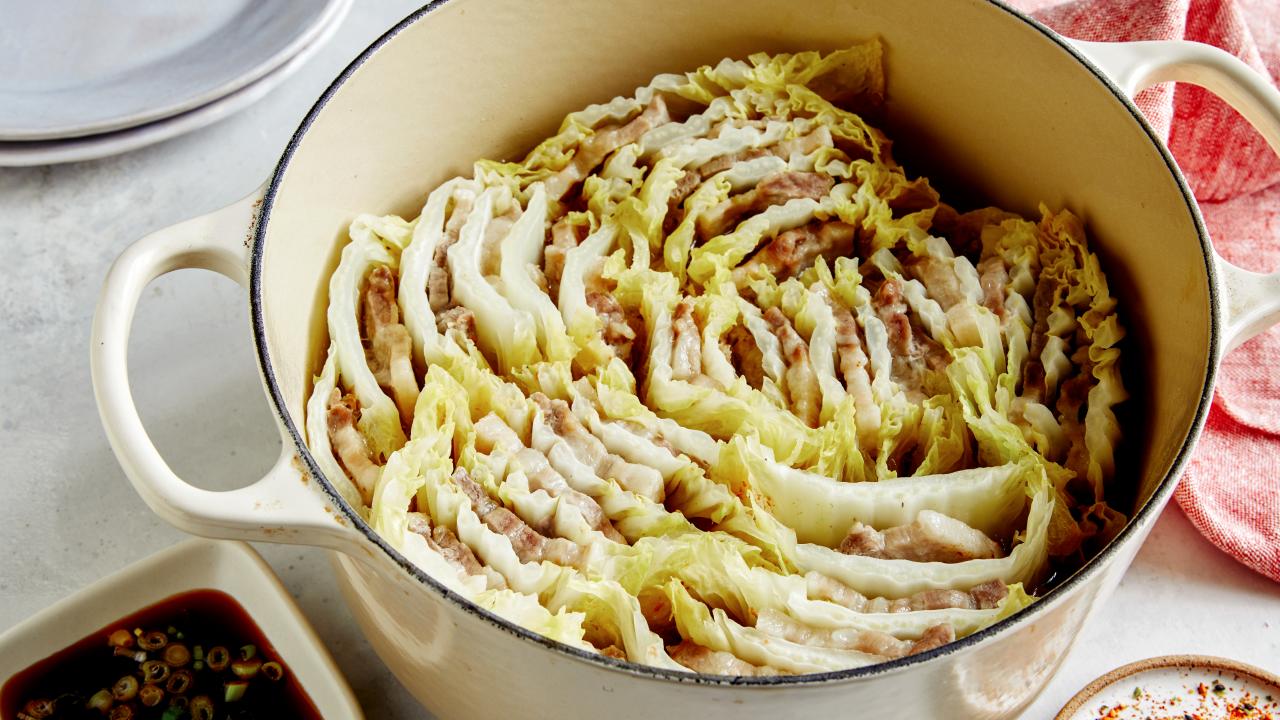Mille-Feuille Nabe
- Level: Easy
- Total: 1 hr 5 min
- Active: 45 min
- Yield: 4 to 6 servings
-
- Nutritional Analysis
- Per Serving
- Serving Size
- 1 of 6 servings
- Calories
- 670
- Total Fat
- 61 g
- Saturated Fat
- 22 g
- Carbohydrates
- 9 g
- Dietary Fiber
- 3 g
- Sugar
- 3 g
- Protein
- 21 g
- Cholesterol
- 82 mg
- Sodium
- 2423 mg
- Level: Easy
- Total: 1 hr 5 min
- Active: 45 min
- Yield: 4 to 6 servings
-
- Nutritional Analysis
- Per Serving
- Serving Size
- 1 of 6 servings
- Calories
- 670
- Total Fat
- 61 g
- Saturated Fat
- 22 g
- Carbohydrates
- 9 g
- Dietary Fiber
- 3 g
- Sugar
- 3 g
- Protein
- 21 g
- Cholesterol
- 82 mg
- Sodium
- 2423 mg
Ingredients
Dashi:
Directions
- Lay a large cabbage leaf on a work surface, curve-side up, and cover with pork belly slices. If the slices are long, 2 slices should be enough. Don’t worry about covering every bit of the cabbage (see Cook's Note).
- Lay another large cabbage leaf on top of the pork, curve-side up, and cover with pork belly slices. Repeat the process 4 more times to form 1 stack of 6 cabbage leaves layered with pork.
- Make more stacks of 6 leaves layered with pork until you’ve used up all the pork. If you run out of larger leaves, piece together smaller leaves of cabbage as needed and stack with the remaining pork. Reserve any remaining smaller pieces of cabbage in case they are needed to pack the center of the pot.
- Carefully cut each stack crosswise into 3 equal sections, gently holding the layers together as you cut.
- Working one section at a time, place the section cut-side up and bottom-side out against the side of a 10-inch-wide, 6-quart Dutch oven or other heavy-bottomed pot. Place another section right next to the first in the same manner. Repeat, packing the sections tightly (see Cook’s Note), until the circle is complete.
- Continue arranging the sections in the pot, packing them tightly, until full. Place the reserved smaller cabbage leaves in any empty spaces in the center, trimming them as needed.
- Whisk the dashi, soy sauce and salt in a large bowl until the salt dissolves and pour into the pot. Cover and bring to a simmer over medium-high heat. Cook until the pork belly is cooked through and the cabbage is just tender, skimming off any foam and impurities, 6 to 10 minutes. Gently stir in the sake if using.
- Pour 1/4 cup of ponzu sauce into 4 or 6 small bowls (depending on the number of diners) and top each one with the scallions. Serve the nabe in shallow bowls and sprinkle with shichimi togarashi if using. Alternatively, set the pot on the table and allow everyone to help themselves.
Dashi:
- Combine the kombu with 6 cups cold water in a medium saucepan and let steep for about 30 minutes. (Skip this step if you are short on time though it lend a deeper flavor.) Heat over medium heat until the water comes to a near boil, about 10 minutes. Discard the kombu.
- Sprinkle the katsuobushi evenly over the water and bring to a boil over high heat. Immediately remove from the heat and let steep without stirring for about 10 minutes.
- Pour the dashi through a fine-mesh strainer into a large bowl. Do not press down on the katsuobushi which can make the dashi cloudy and/or bitter.
- Dashi is best used the day it is made but can be cooled and refrigerated in an airtight container for up to 3 days.
Cook’s Note
Pre-sliced pork belly is available at Asian grocery stores. You can also ask a butcher to cut a 1 1/2-pound piece of pork belly into long bacon-like strips or do it yourself. The ideal thickness for this dish is about 1/16 inch, but about 1/8 inch is fine, too. It helps to partially freeze the pork first and use a very sharp knife. If your pork slices are thicker, you may have to use fewer per layer in order to have enough for the leaves. For the mille-feuille to keep its shape during cooking it’s important to pack the pork-and-cabbage sections tightly in the pot. Serve the rice separately or it will soak up the broth and dilute the flavor.
Looking for Something Else?
Related Pages
- Marvelous Mille-Feuille Recipe
- Mille-Feuille In A Whiskey Glass Recipe
- Fig and Balsamic Syrup Mille Feuille Recipe
- Butterscotch Mille-Feuille Recipe
- Black and White Mille-Feuille Recipe
- Mille-Feuille of Foie Gras and Pain d'epice with...
- PB and J Mille Feuille Recipe
- Mille-Feuille with Vanilla Pastry Cream and...
- Shortcut Lemon-Raspberry Mille-Feuille Recipe

































